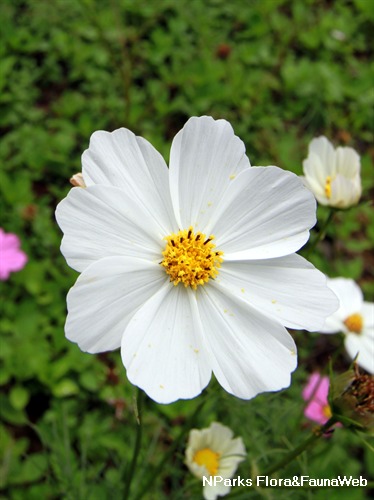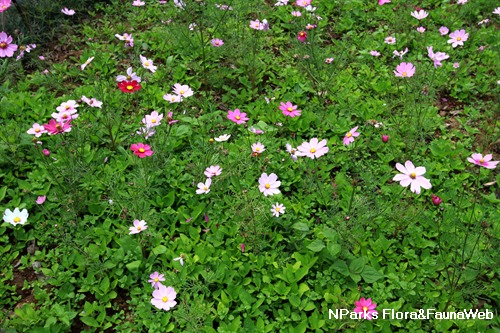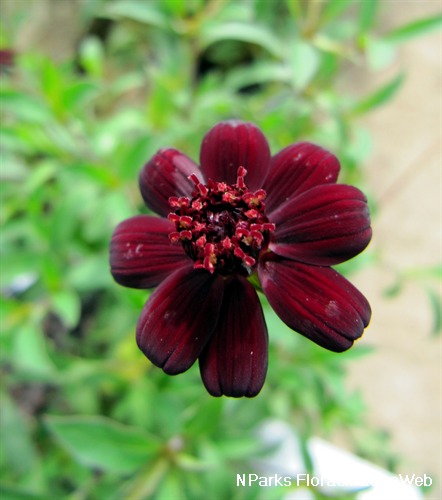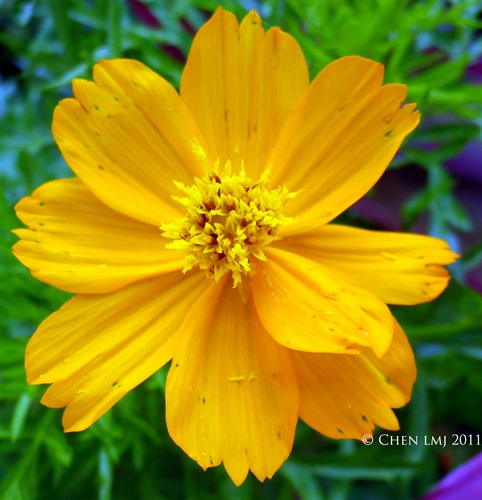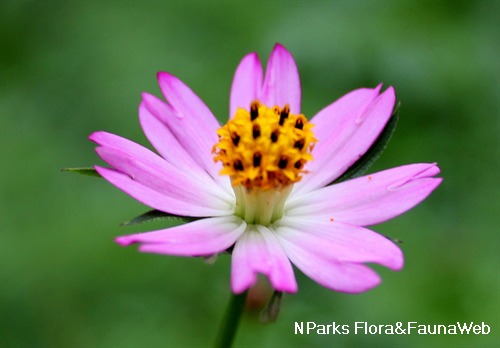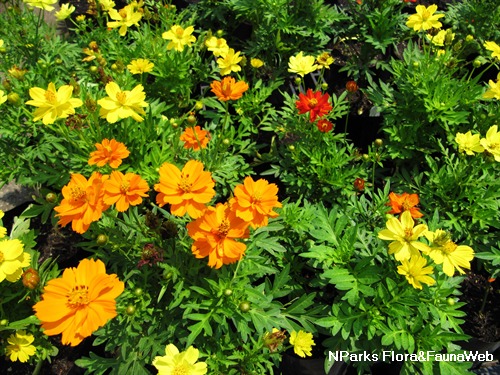
Back
Cosmos bipinnatus Cav.
| Family Name: | Asteraceae (Compositae) |
| Synonyms: | Coreopsis formosa Bonato, Cosmos hybridus Anon., Bidens formosa Sch.Bip., Cosmos tenuifolius Lindl. |
| Common Name: | Cosmos, Garden Cosmos, Mexican Aster, Cut Leaf Cosmos, Spanish Needles, 秋英 |
Name
Classifications and Characteristics
| Plant Division | Angiosperms (Flowering Seed Plants) (Dicotyledon) |
|---|---|
| Plant Growth Form | Herbaceous Plant |
| Lifespan (in Singapore) | Annual |
| Mode of Nutrition | Autotrophic |
| Plant Shape | Shrubby, Columnar |
| Maximum Height | 1.5 m to 2.5 m |
| Maximum Plant Spread / Crown Width | 0.1 m to 0.5 m |
Biogeography
| Native Distribution | Mexico |
|---|---|
| Native Habitat | Terrestrial |
| Preferred Climate Zone | Temperate |
| Local Conservation Status | Non-native (Horticultural / Cultivated Only) |
Description and Ethnobotany
| Growth Form | Herbaceous plant up to 2.5 m tall. |
|---|---|
| Foliage | The leaf is finely divided into narrow linear segments. It either does not have a leaf stalk known as a petiole, or it has a short one. |
| Stems | Stems are mostly glabrous, sometimes minutely hairy and terete. |
| Flowers | The daisy-like inflorescence is a compound head composed of white or pink, petal-like ray florets which surround a yellow centre made up of disc florets. |
| Fruit | Dry, one-seed fruit does not break open to release the seed and is known as an achene. |
| Cultivation | It grows best in moist, well-drained soil. It is prone to attack by aphids and slugs. Pruning away spent blossoms will prolong the flowering period. |
| Ethnobotanical Uses | Edible Plant Parts : Edible Leaves, Edible Stems Food (Fruit or Vegetable): Young shoots are edible. |
Landscaping Features
| Desirable Plant Features | Ornamental Flowers |
|---|---|
| Landscape Uses | Parks & Gardens, Small Gardens, Flowerbed / Border |
Fauna, Pollination and Dispersal
| Fauna Pollination Dispersal Associated Fauna | Butterfly-Attracting |
|---|---|
| Pollination Method(s) | Biotic (Fauna) (Insects (Butterfly, Moth), Insects (Bee), Insects (Ant, Beetle, Fly, Thrip, Wasp)) |
Plant Care and Propagation
| Light Preference | Full Sun |
|---|---|
| Water Preference | Moderate Water |
| Plant Growth Rate | Fast |
| Rootzone Tolerance | Moist Soils, Well-Drained Soils, Fertile Loamy Soils |
| Maintenance Requirements | Low |
| Pruning | Pinch back the leading shoots to induce more bushy growth. |
| Diseases | It may develop grey mould. |
| Pest(s) | Sucking Insects |
| Propagation Method | Seed |
Foliar
| Foliage Retention | Evergreen |
|---|---|
| Mature Foliage Colour(s) | Green |
| Mature Foliage Texture(s) | Thin |
| Foliar Type | Compound (Bipinnate) |
| Foliar Arrangement Along Stem | Opposite |
| Foliar Attachment to Stem | Sessile |
| Foliar Shape(s) | Non-Palm Foliage |
| Foliar Margin | Entire |
| Foliar Apex - Tip | Acute |
| Typical Foliar Size | 6 cm to 8 cm |
Non - Foliar and Storage
| Root Type | Underground |
|---|
Floral (Angiosperm)
| Flower & Plant Sexuality | Bisexual Flowers |
| Flower Colour(s) | White, Purple, Pink, Yellow / Golden |
|---|---|
| Flower Texture(s) | Wrinkled |
| Flower Grouping | Cluster / Inflorescence |
| Flower Location | Terminal |
| Flower Symmetry | Bilateral |
| Inflorescence Type | Compound Head / Capitulum |
| Flowering Habit | Polycarpic |
| Inflorescence Size | 8 cm |
References
| References | Polunin, Ivan. 2010. Plants and Flowers of Singapore. Malaysia: Marshall Cavendish Editions . |
|---|
Image Repository
Others
| Master ID | 29374 |
|---|---|
| Species ID | 3683 |
| Flora Disclaimer | The information in this website has been compiled from reliable sources, such as reference works on medicinal plants. It is not a substitute for medical advice or treatment and NParks does not purport to provide any medical advice. Readers should always consult his/her physician before using or consuming a plant for medicinal purposes. |


